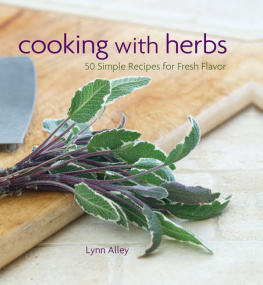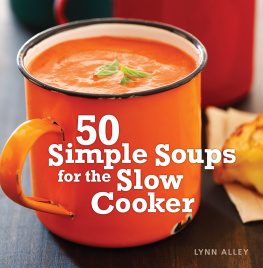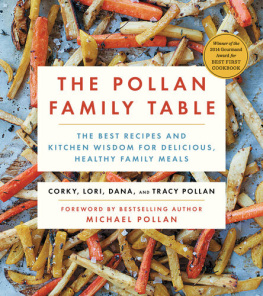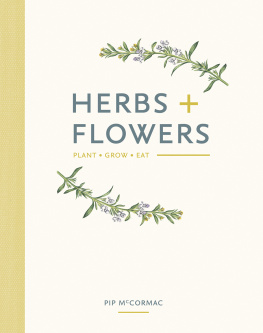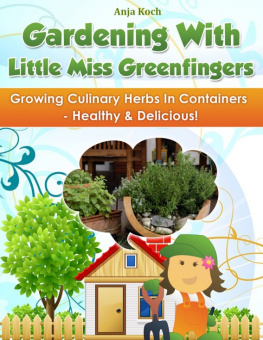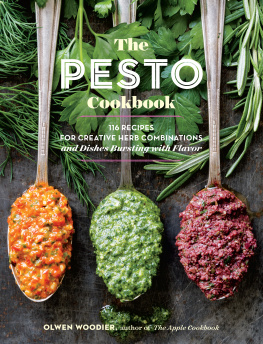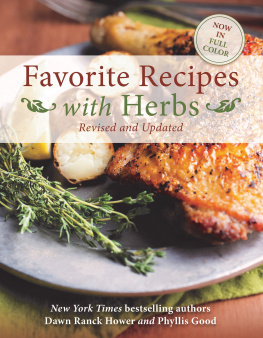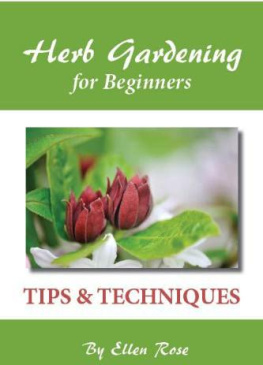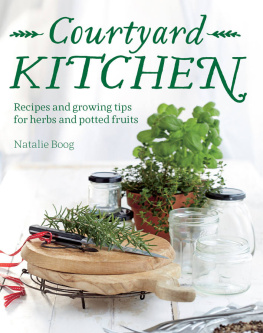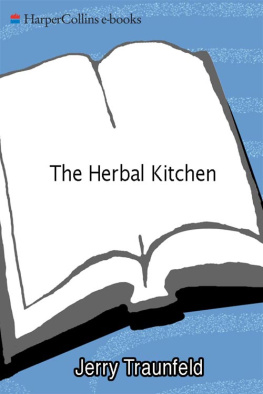
Cooking with Herbs copyright 2013 by Lynn Alley. Photography copyright 2013 by Dhanraj Emanuel. All rights reserved. No part of this book may be used or reproduced in any manner whatsoever without written permission except in the case of reprints in the context of reviews.
Andrews McMeel Publishing, LLC
an Andrews McMeel Universal company
1130 Walnut Street, Kansas City, Missouri 64106
www.andrewsmcmeel.com
ISBN: 9781449431631
Library of Congress Control Number: 2012949684
Photography by Dhanraj Emanuel
Design and illustrations by Julie Barnes
ATTENTION: SCHOOLS AND BUSINESSES
Andrews McMeel books are available at quantity discounts with bulk purchase for educational, business, or sales promotional use. For information, please e-mail the Andrews McMeel Publishing Special Sales Department: specialsales@amuniversal.com
Introduction
When I was a child, my mother kept a shelf in the kitchen cabinet devoted to dried herbs. The old Schilling red-and-white cans. I knew a few names, but had no idea how to use them or what their distinguishing characteristics might be. I was far more interested in the chocolate chips she kept hidden behind them than in the herbs themselves.
My high school English teacher, Laurie Staude, was the first to draw my attention to fresh herbs. I admired her. She carried on at some length one day about an omelet sprinkled with fresh-picked rosemary. I did not know what an omelet was, but I could use my imagination. So I headed off to a Renaissance Pleasure Faire in the hills of Marin County that had a gypsy wagon selling small herbs in pots. I bought a rosemary plant and carefully carried it home, set it in my bedroom window, and tended it with loving care. Then I chopped the first of its leaves and sprinkled them over a poached egg, believing that perhaps this was an omelet.
My second encounter was also with rosemary. A college friend and I were traveling from California to the Grand Canyon during spring break and I was doing the roadside cooking. We stopped at a gas station somewhere near Kingman, Arizona, and I noticed some scruffy plants around the periphery of the gas station. They smelled like rosemary, so I took some cuttings and used them on that nights chicken dinner. Delish!
A couple of years later, when I had a garden with some space behind my college house, I actually planted an herb and vegetable garden all of my own. (I will not forget the very first dish I made from my garden treasures: a soup of cabbage, tomatoes, and rosemary.) By that time, I had become interested in both the medicinal and the culinary uses of herbs, so I had great fun cooking and mixing herbal decoctions for colds and flu.
Jump forward a few years and I was living in Southern California, leading tours, teaching herb cooking classes, and catering herb lunches at the largest herb nursery in the United States. Very little in this world could compare to a saunter through the mother garden on a warm day. Aromas of rosemary, oregano, sage, and more exotic herbs would rise up to meet me as I brushed against them. What a beautiful place it was! My lunches were redolent with juicy, herb-filled recipes and were ultimately laid out picnic style on the large rolling lawn that sloped down to the pond. Many of the recipes I developed then are still in my repertoire today; in fact, you might even find some of them in this book.
Truth be known, the garden itself was the inspiration for my cooking. Rather than choosing main ingredients around which to build a dish, I chose my herb or herbs from what looked good on any given day, then built my dish around them. As one of my culinary heroes, Angelo Pellegrini, wrote in his book The Food Lovers Garden,
The garden becomes, as it has for me, a veritable arsenal of culinary suggestions. As you survey what you have grown, and come to know their individual and collective virtues, they suggest what use you may make of them on any given day to produce a good dinner. I know whereof I speak, for I have learned to listen to mine. And they have never disappointed me.
As I look back over the years, I can see the ways in which herbs have woven themselves in and out of my life. Even today, I continue to enjoy them in the garden, the kitchen, and even in flower arrangements throughout the house.
A Word About Herbs
First, a distinction: The term herb is used for the green parts (leaves) of aromatic plants, whereas the term spice refers to woody plant parts and seeds, such as cinnamon (bark) or coriander seed.
No one knows for sure why herbs developed such strong smells and flavors, but scientists have surmised that the sometimes bitter, aromatic oils that develop in little pods on the surface of the leaves are a natural insect repellent. In addition, these little oil glands also store moisture in the form of oil in the leaves, useful in the dry Mediterranean climate where many herbs originated and where water would quickly evaporate.
It is these oils (also called volatile oils or aromatic oils ) that give the plant its characteristic flavor and aroma. As it turns out, the better the growing conditions (good soil, plenty of nutrients, and adequate water), the more fully these little glands develop.
Because the oils are so volatile (they evaporate quickly and easily), most herbs, unlike spices, dont stand up well to prolonged cooking periods, and should best be added at the end of the cooking time.
How and why did people first begin to use herbs in their cooking? I can only guess that these flavorful green things made even the plainest ingredients taste more appealing.
Many years ago, I was working on a biography and staying in a small trailer near the creek that runs through Davis, California. The only cooking implements left behind by the
former occupant were an old vintage 1970s Crock-Pot and a very unstable old frying pan. In the spirit of adventure, I went to the local co-op and purchased every kind of bean it had, then cooked my way through them, taking just one kind of bean, cooking it, adding some good salt and then walking outside the kitchen to see what herbs were in the garden. I would usually flavor each soup with only one herb just to get a feeling for the purity of flavors in both the beans and the herb.
It may sound dull to some, but it was a wonderful experiment and led me to a career writing about the many things that can be done with a slow cookerand now with herbs. Both are so practical and so useful for just about anything and everything.
I invite you to begin the adventure of getting to know the herbs in your garden (or out in nature) and to view any recipes as points of departure rather than as destinations in themselves. For this reason, I have chosen to present my recipes around a series of templates, or basic recipes that can become as different as night and day, depending upon how you choose to vary and arrange your ingredients. And I encourage you to play around with them and develop your own style and your own repertoire of recipes that work for you, your family, and your friends.
As with my book 50 Simple Soups for the Slow Cooker , I have taken an easy on the planet, the pocketbook, and the palate approach because I believe many people today are looking for dishes that are easy to make, soul satisfying, and yet have a conscience.
I see no need for exotic ingredients, when in many cases, you can eat very well from your own backyard, supplemented by a few items from the farmers market and supermarket.
Next page
